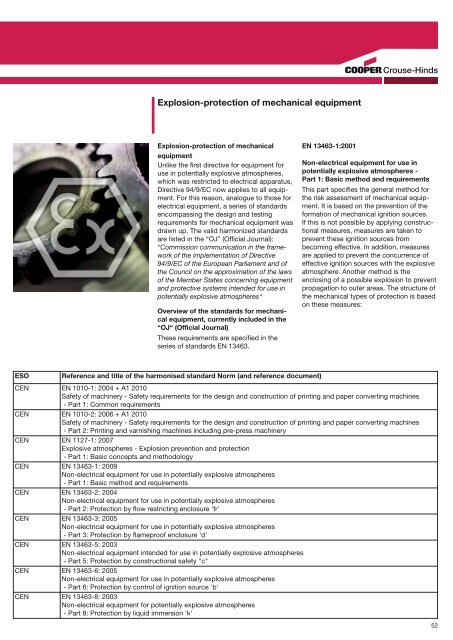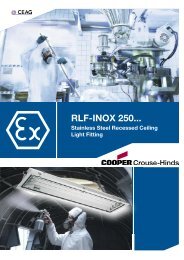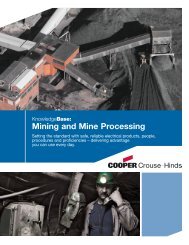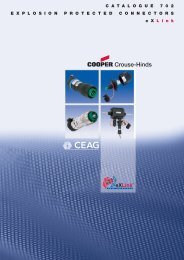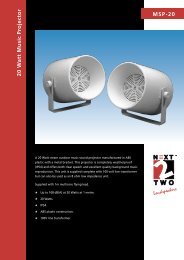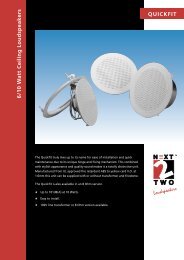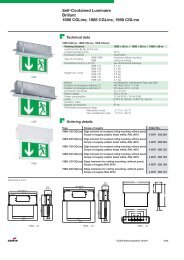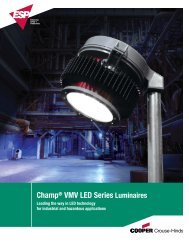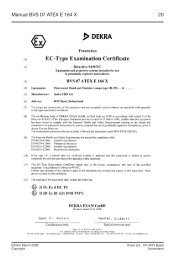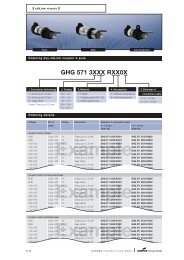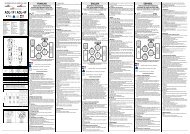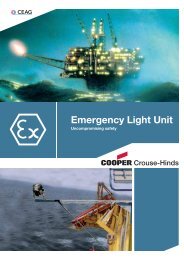Principles of Explosion-Protection
Principles of Explosion-Protection - Acasa | Intec Automatizari
Principles of Explosion-Protection - Acasa | Intec Automatizari
- No tags were found...
Create successful ePaper yourself
Turn your PDF publications into a flip-book with our unique Google optimized e-Paper software.
<strong>Explosion</strong>-protection <strong>of</strong> mechanical equipment<strong>Explosion</strong>-protection <strong>of</strong> mechanicalequipmentUnlike the first directive for equipment foruse in potentially explosive atmospheres,which was restricted to electrical apparatus,Directive 94/9/EC now applies to all equipment.For this reason, analogue to those forelectrical equipment, a series <strong>of</strong> standardsencompassing the design and testingrequirements for mechanical equipment wasdrawn up. The valid harmonized standardsare listed in the “OJ” (Official Journal):“Commission communication in the framework<strong>of</strong> the implementation <strong>of</strong> Directive94/9/EC <strong>of</strong> the European Parliament and <strong>of</strong>the Council on the approximation <strong>of</strong> the laws<strong>of</strong> the Member States concerning equipmentand protective systems intended for use inpotentially explosive atmospheres“Overview <strong>of</strong> the standards for mechanicalequipment, currently included in the“OJ“ (Official Journal)These requirements are specified in theseries <strong>of</strong> standards EN 13463.EN 13463-1:2001Non-electrical equipment for use inpotentially explosive atmospheres -Part 1: Basic method and requirementsThis part specifies the general method forthe risk assessment <strong>of</strong> mechanical equipment.It is based on the prevention <strong>of</strong> theformation <strong>of</strong> mechanical ignition sources.If this is not possible by applying constructionalmeasures, measures are taken toprevent these ignition sources frombecoming effective. In addition, measuresare applied to prevent the concurrence <strong>of</strong>effective ignition sources with the explosiveatmosphere. Another method is theenclosing <strong>of</strong> a possible explosion to preventpropagation to outer areas. The structure <strong>of</strong>the mechanical types <strong>of</strong> protection is basedon these measures:ESOReference and title <strong>of</strong> the harmonised standard Norm (and reference document)CEN EN 1010-1: 2004 + A1 2010Safety <strong>of</strong> machinery - Safety requirements for the design and construction <strong>of</strong> printing and paper converting machines- Part 1: Common requirementsCEN EN 1010-2: 2006 + A1 2010Safety <strong>of</strong> machinery - Safety requirements for the design and construction <strong>of</strong> printing and paper converting machines- Part 2: Printing and varnishing machines including pre-press machineryCEN EN 1127-1: 2007Explosive atmospheres - <strong>Explosion</strong> prevention and protection- Part 1: Basic concepts and methodologyCEN EN 13463-1: 2009Non-electrical equipment for use in potentially explosive atmospheres- Part 1: Basic method and requirementsCEN EN 13463-2: 2004Non-electrical equipment for use in potentially explosive atmospheres- Part 2: <strong>Protection</strong> by flow restricting enclosure 'fr'CEN EN 13463-3: 2005Non-electrical equipment for use in potentially explosive atmospheres- Part 3: <strong>Protection</strong> by flamepro<strong>of</strong> enclosure 'd'CEN EN 13463-5: 2003Non-electrical equipment intended for use in potentially explosive atmospheres- Part 5: <strong>Protection</strong> by constructional safety "c"CEN EN 13463-6: 2005Non-electrical equipment for use in potentially explosive atmospheres- Part 6: <strong>Protection</strong> by control <strong>of</strong> ignition source 'b'CEN EN 13463-8: 2003Non-electrical equipment for potentially explosive atmospheres- Part 8: <strong>Protection</strong> by liquid immersion 'k'52


